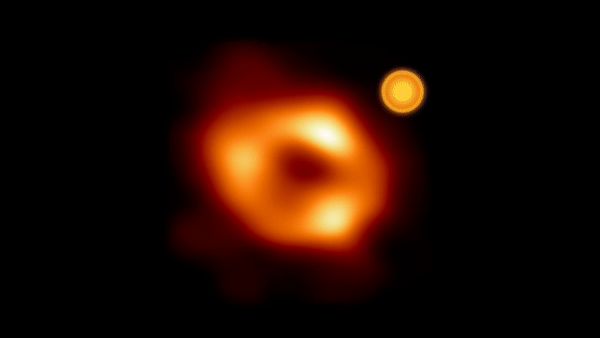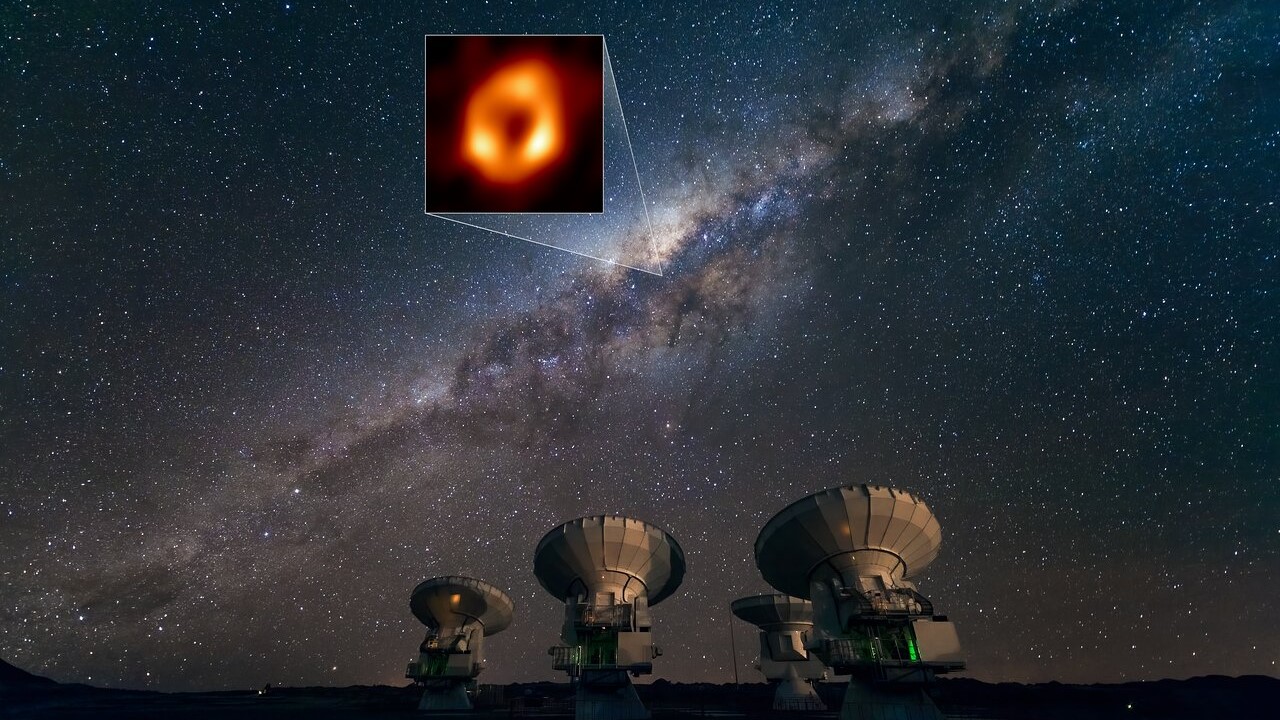Superhot blob of gas discovered orbiting Milky Way's black hole at 'mind-blowing' velocity
The bizarre blob was traveling at 30% the speed of light.

Astronomers have detected a blob of hot gas whizzing around the supermassive black hole at the heart of our galaxy at an extraordinary speed. A powerful magnetic field surrounding the colossal space-time tear has supercharged the bizarre gaseous globule, speeding it up to 30% the speed of light, a new study finds.
The supermassive black hole at the center of the Milky Way, known as Sagittarius A*, is around 4 million times more massive than the sun and stretches around 40 million miles (60 million kilometers) across. Normally, anything that gets too close to such a massive black hole gets dragged beyond its event horizon by an overwhelming gravitational pull. But the newly discovered gas blob, or hot spot, is moving so quickly that it appears to have formed a stable orbit around the massive cosmic void.
The gaseous blob's orbit around Sagittarius A* is equivalent in size to the orbit of Mercury around the sun. But the blazing blob completes a full rotation around the black hole every 70 minutes, compared with the 88 days it takes Mercury to travel the same distance, researchers wrote in a new paper published online Sept. 22 in the journal Astronomy and Astrophysics.
"This requires a mind-blowing velocity of about 30% of the speed of light," study lead author Maciek Wielgus, an astronomer at the Max Planck Institute for Radio Astronomy in Germany, said in a statement. That's around 201.2 million mph (323.8 million km/h), or around 3,000 times faster than Earth moves around the sun.
Related: Are black holes wormholes?
Researchers first spotted the orbiting blob in 2017 using the Atacama Large Millimeter/submillimeter Array (ALMA) telescope in Chile. The ALMA telescope, which is made up of 66 antennae, is one of eight telescopes that make up the Event Horizon Telescope (EHT) network, which produced the first direct image of Sagittarius A* in May this year.
Researchers were calibrating ALMA to focus on Sagittarius A* for the EHT project when they detected an unusual X-ray flare coming from the space surrounding the black hole.
Sign up for the Live Science daily newsletter now
Get the world’s most fascinating discoveries delivered straight to your inbox.
The electromagnetic radiation from the flare, which was also visible in infrared and radio, was highly polarized, or twisted, and showed signs of synchrotron acceleration — in which an object is subject to an acceleration perpendicular to its velocity. This type of acceleration occurs when charged particles are propelled forward by a strong magnetic field, like how artificial particle accelerators supercharge electrons, according to ScienceAlert.
The only explanation for this type of acceleration is that the flare originated from the black hole's magnetically arrested disk — a ring of matter surrounding a black hole that is being held in place by a strong magnetic field, which counterbalances the forces of gravity pulling the matter into the cosmic void. Researchers, therefore, deduced that the only possible origin of the flare was a supercharged gas blob trapped within this disk.
Different research groups have detected similar signals from hot spots rapidly orbiting other black holes, according to the statement. However, this is the first time that a flare emitted by a hot spot have been observed in radio as well as infrared and X-ray, the researchers wrote in the paper.

The researchers think that the radio waves they detected could mean that the hot spot is slowing down and losing some of its energy, according to the statement. This could potentially signal that the gas blob will eventually slow down enough for the black hole's gravity to overcome the magnetic shielding surrounding it and finally pull the gas into its infinite maw.
The researchers hope that this new information can be used to help track additional hot spots around other black holes.
"In the future, we should be able to track hot spots across frequencies using coordinated multiwavelength observations," study co-author Ivan Marti-Vidal, a radio astronomer at The University of Valencia in Spain, said in the statement. "The success of such an endeavor would be a true milestone for our understanding of the physics of flares in the galactic center."
Related: Do black holes explode?
While the new study improves our understanding of the Milky Way's black hole heart, researchers said there is still a lot more to learn about Sagittarius A*.
Until now, telescopes have struggled to focus in on the supermassive structure because it frequently flares up, shooting out electromagnetic radiation that interferes with delicate sensors. But the new James Webb Space Telescope will play a key role in future research into Sagittarius A* because it will be able to see past this interference.
"Hopefully, one day, we will be comfortable saying that we 'know' what is going on in Sagittarius A*," Wielgus said. But that day is not today.
Originally published on Live Science.

Harry is a U.K.-based senior staff writer at Live Science. He studied marine biology at the University of Exeter before training to become a journalist. He covers a wide range of topics including space exploration, planetary science, space weather, climate change, animal behavior and paleontology. His recent work on the solar maximum won "best space submission" at the 2024 Aerospace Media Awards and was shortlisted in the "top scoop" category at the NCTJ Awards for Excellence in 2023. He also writes Live Science's weekly Earth from space series.









